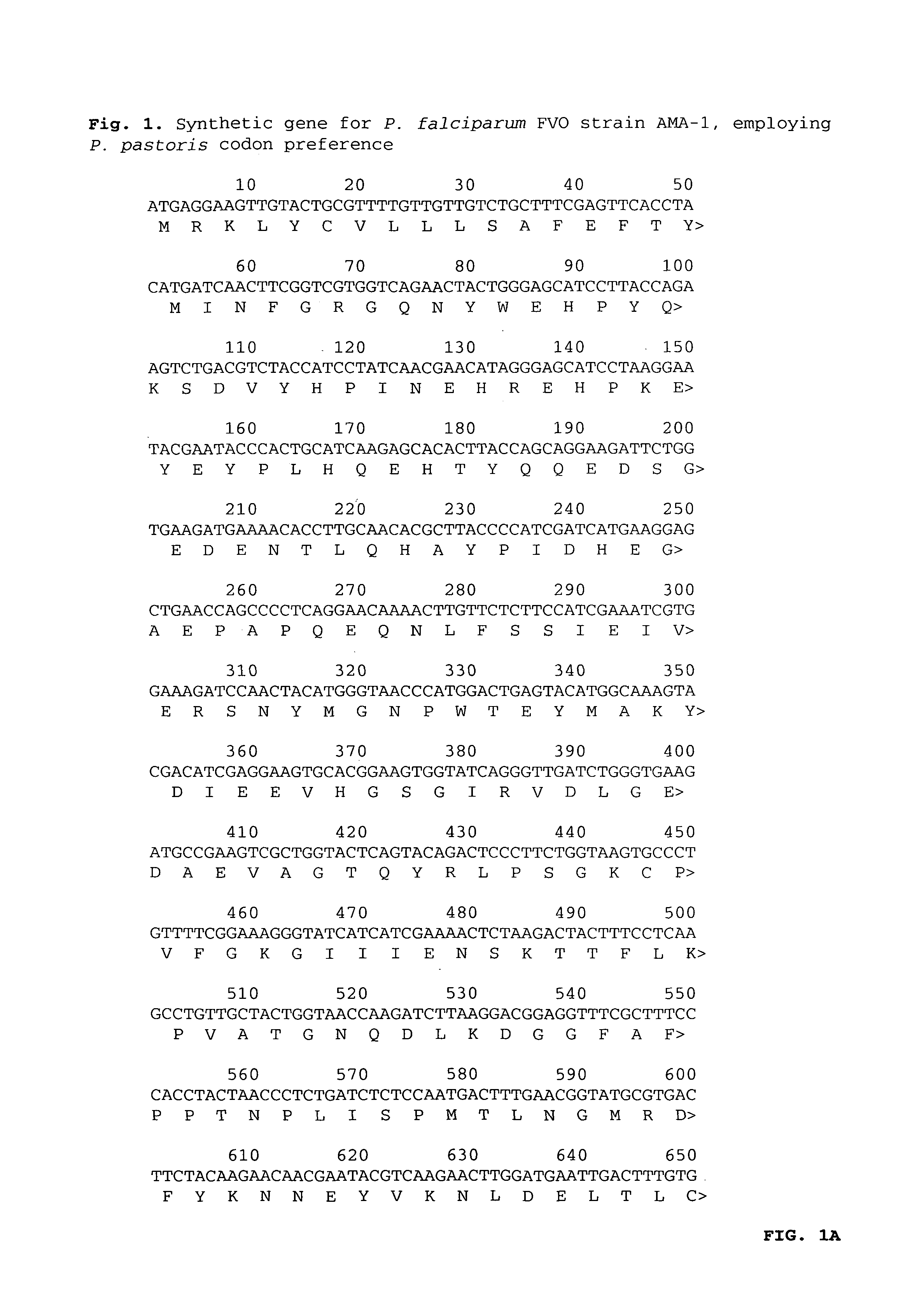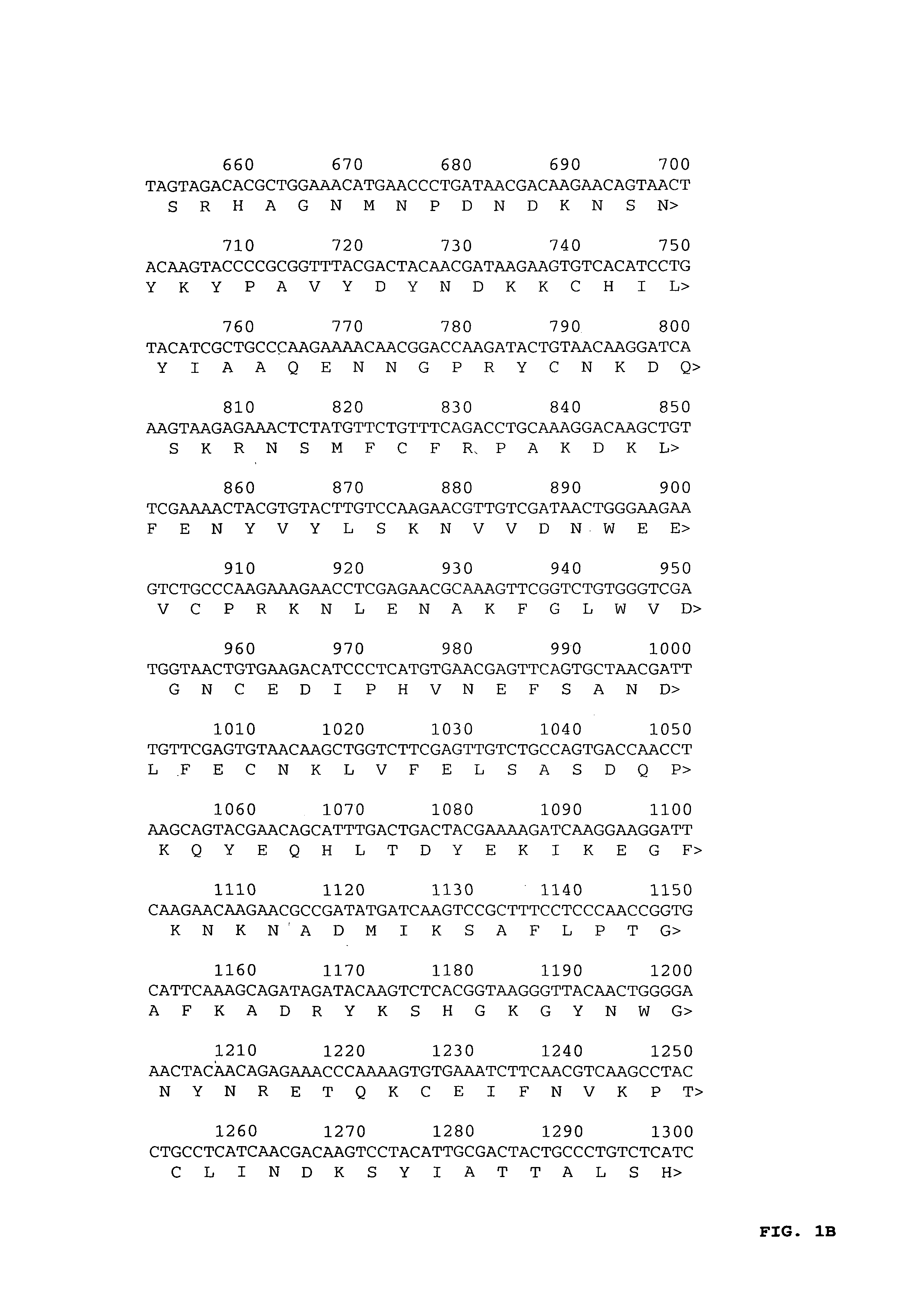Efficient expression of Plasmodium apical membrane antigen in yeast cells
- Summary
- Abstract
- Description
- Claims
- Application Information
AI Technical Summary
Benefits of technology
Problems solved by technology
Method used
Image
Examples
example 1
Development of Synthetic Gene for P. falciparum FVO Strain Pf AMA-1
1.1 Original FVO Sequence
[0048]Cryopreserved parasite stocks from P. falciparum FVO were prepared from an infected Aotus lemurinus griseimembra monkey at the young ring stage of development and DNA was isolated (Gentra Systems Inc., Minneapolis, Minn.) directly from a parasite stock according to the manufacturer's instructions. Pf AMA-1 was amplified by polymerase chain reaction using Pfu polymerase (Promega, Leiden, The Netherlands) and primers PF83A: 5′-GGGGGATCCATGAGAAAATTATACTGCGTATT-3′ (nt 1-23 and additional BamHI restriction site, SEQ ID NO:1) and PF83B: 5′-ACGTGGATCCTTAATAGTATGGTTTTTCCATCAGAACTGG-3′ (complementary to nt 1843-1869 and additional BamHI restriction site, SEQ ID NO:2) containing BamHI restriction sites to facilitate cloning in pBluescript. A pool of four independent clones was used for sequence analysis using an ABI PRISM™ 310 automated sequencer (PE Applied Biosystems, Foster City, Calif.) accor...
example 2
Expression of FVO Pf83syn Ectodomain in P. pastoris
2.1 Development of Expression Constructs
[0051]For secreted expression in P. pastoris strain KM71H, we used vector pPICZα A (Invitrogen). This vector provides an N-terminal signal sequence and a C-terminal myc epitope followed by a 6×His tag for easy purification. Gene fragments have to be cloned in frame with these sequences. Primers for PCR amplification of the Pf AMA-1 ectodomain were Pf83A: 5′-GGAATTCCAGAACTACTGGGAGCATCC-3′ (nt 73-92 and additional EcoRI restriction site, SEQ ID NO:3) and Pf83H: 5′-GCTCTAGAATGTTATCGTAACGTAGGCTT-3′ (complementary to nt 1615-1634 and additional XbaI restriction site, SEQ ID NO:4) or Pf83A and Pf83I: 5′-GCTCTAGACTACATGTTATCGTACGTAGGCTT-3′ (complementary to nt 1615-1635, plus stop codon plus additional XbaI restriction site; this provides the full ectodomain without myc epitope and His tag, SEQ ID NO:5). A 50 μL PCR reaction contained 10 ng template DNA (FVO Pf83syn), 100 ng of each of the primers P...
example 3
Bulk Production
[0070]Pf11-0.1 has undergone a feasibility study for GMP production at a GMP production facility. Pilot fermentations at 5-10 L scale have been performed to assess parameters that influence proteolytic degradation and yield. The conclusion was that addition of 0.4 mM EDTA to the standard fermentation medium at pH 6.0, as well as methanol induction with a high cell density for a short period of 30 hours, and immediate freezing of the harvested culture supernatant until processing, are all beneficial to prevent proteolytic degradation. For purification, best results were obtained by direct binding of Pf AMA-1 on an immobilized metal affinity column activated with CuSO4 (LMAC). This step also removes proteases from Pf AMA-1 resulting in an increase in stability of the partially purified product. The general conclusion of the feasibility study is that it is feasible to produce 1 gram of protein with a minimum purity of 98% for Phase I clinical testing.
[0071]For mid-scale ...
PUM
| Property | Measurement | Unit |
|---|---|---|
| Mass | aaaaa | aaaaa |
| Fraction | aaaaa | aaaaa |
| Fraction | aaaaa | aaaaa |
Abstract
Description
Claims
Application Information
 Login to View More
Login to View More - R&D
- Intellectual Property
- Life Sciences
- Materials
- Tech Scout
- Unparalleled Data Quality
- Higher Quality Content
- 60% Fewer Hallucinations
Browse by: Latest US Patents, China's latest patents, Technical Efficacy Thesaurus, Application Domain, Technology Topic, Popular Technical Reports.
© 2025 PatSnap. All rights reserved.Legal|Privacy policy|Modern Slavery Act Transparency Statement|Sitemap|About US| Contact US: help@patsnap.com



